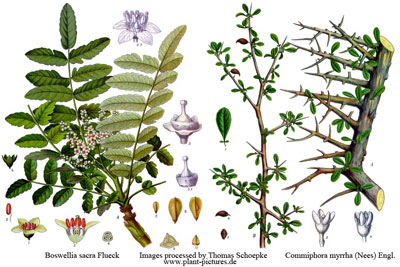January 6th is Epiphany, or Twelfth Night, when as well as taking our Christmas decorations down, we remember the three wise kings who followed the star of Bethlehem and delivered their very special gifts, gold, frankincense and myrrh to the infant Jesus.
These three gifts have huge religious significance, but frankincense and myrrh have been used medicinally and cosmetically for thousands of years. Aromatherapists still values them today for their special qualities and I’ve a few recommendations for you, based on my own aromatherapy practice.
Frankincense Essential Oil is steam-distilled from the gum resin that oozes from incisions made in the bark of the trees –
(Boswellia carterii) – with abundant narrow leaves and white or pale-pink flowers. These grow throughout the Middle East and the oil is spicy, balsamic, green-lemon-like and peppery.
Frankincense played a role in the religious and domestic life of the Ancient Egyptian, Babylonian, Persian, Hebrew, Greek and Roman civilisations. It has been perhaps the most important aromatic incense ingredient since history began. This is reflected in the fact that its English name is derived from the medieval French word franc, meaning “pure” or “free”, and the Latin incensium, “to smoke”. It was also used as a cosmetic, the charred gum was used as kohl by Egyptian women.
Oil possesses anticatarrhal and expectorant properties, useful for bronchitis and asthma, especially when associated with nervous tension: the oil is said to “Deepen the breath” and can relieve feelings of tightness in the chest. It may also be used for sinusitis and laryngitis – inhalation.
Aromatherapy benefits:visualizing, meditative to the mind.
On a mental level, can help with states of depression or feeling mentally overloaded (nervous tension or nervous exhaustion) and can help to calm the mind and aid mental clarity – probably why it has been used in religious rituals, incensors and meditation for millenia.
I love using frankincense essential oil and find it very useful for people who have a long standing congested chest as a result of an infection or asthma. I have also used it with some success as part of treatment where bereavement is an issue, but I haven’t confined the definition of bereavement to loss due to the death of someone close. A great sense of loss can be experienced if you lose your job, discover you have a life limiting illness or your children leave the family nest to set up in their own home.
In all of these instances, frankincense used as part of an aromatherapy treatment has given comfort and helped to relieve some of the sorrow of loss. It is said that frankincense helps us to close a door on a part of our lives but helps us to move on and open other doors.
Myrrh is an interesting oil, harvested and distilled in a similar manner to frankincense and is the resin of the Commiphora Myrrha tree, a small thorny bush that grows in dry stony soil, ideal for the Yemen, Somalia, Ethiopia and Eritrea where it grows naturally.
Not only is it famous for being one of the special gifts along with gold and frankincense brought by the magi to the baby Jesus, but it was also supposedly used at his death. His body was wrapped in linen infused with a mixture of aloes and myrrh. The Ancient Egyptians used Myrrh as part of their embalming rituals and it has a wide range of applications, even today.
Like frankincense, it has both important physical and spiritual healing properties. Both oils are wonderful on their own or as part of a blend to burn as part of a meditation practice – both oils have been used for thousands of years as part of religious and spiritual traditions.
Balancing Meditation Blend
10 drops frankincense (Boswellia carterii)
10 drops mandarin (Citrus reticulata)
20 drops cedarwood (Cedrus atlantica)
5 drops rosewood (Aniba rosaeodora)
2 drops vetiver (Vetiveria zizanioides)
Add to an aromatherapy diffuser before starting your meditation practice.
Myrrh doesn’t feature highly in aromatherapy text books, but one practical use of myrrh is as part of dental hygiene: it’s an effective remedy for mouth ulcers, for example. On a personal level, I find myrrh sticky and hard to blend as part of an aromatherapy massage oil, but I have used it in a mouth wash: I dissolved 2 drops of tea tree and 1 drop of myrrh in 1 tbsp of brandy then added warm water. I swilled it round my mouth then spat it out (no, I wouldn’t swallow it, even with the brandy in!) It worked really well but was quite a carry on first thing in the morning but you could make up a batch to then add the warm water when you needed it.
I haven’t persisted with this home remedy as I prefer Citricidal, which works well for sore throats, tummy upsets and athletes feet. I have to warn you though it tastes revolting!
Have a happy, peaceful and healthy January and take some time, every day, to look after yourselves.

[contact-form][contact-field label=’Name’ type=’name’ required=’1’/][contact-field label=’Email’ type=’email’ required=’1’/][contact-field label=’Website’ type=’url’/][contact-field label=’Comment’ type=’textarea’ required=’1’/][/contact-form]
